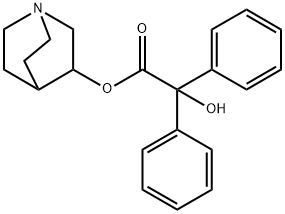
(±)-Quinuclidinyl benzilate
- английское имя3-Quinuclidinyl benzilate
- CAS №6581-06-2
- CBNumberCB1244838
- ФормулаC21H23NO3
- мольный вес337.42
- EINECS233-250-6
- номер MDLMFCD01658356
- файл Mol6581-06-2.mol
химическое свойство
| Температура плавления | 164.5°C |
| Температура кипения | 473.72°C (rough estimate) |
| плотность | 1.1644 (rough estimate) |
| показатель преломления | 1.5614 (estimate) |
| температура хранения | 2-8°C |
| растворимость | chloroform: but decomposes within 24 hrssoluble |
| пка | 11.28±0.29(Predicted) |
| форма | powder |
| цвет | white |
| Справочник по базе данных CAS | 6581-06-2 |
| Рейтинг продуктов питания EWG | 1 |
| FDA UNII | E69DLR7470 |
| Справочник по химии NIST | 3-Quinuclidinyl benzilate(6581-06-2) |
| Система регистрации веществ EPA | Benzeneacetic acid, .alpha.-hydroxy-.alpha.-phenyl-, 1-azabicyclo[2.2.2]oct-3-yl ester (6581-06-2) |
| Коды опасности | Xn,T+ |
| Заявления о рисках | 22-26 |
| Заявления о безопасности | 28-36/37-45 |
| WGK Германия | 3 |
| RTECS | DD4638000 |
| кода HS | 29333910 |
| Банк данных об опасных веществах | 6581-06-2(Hazardous Substances Data) |
| Токсичность | LD50 intraperitoneal in mouse: 103mg/kg |
рисовальное письмо(GHS)
-
рисовальное письмо(GHS)

-
сигнальный язык
опасность
-
вредная бумага
H300:Смертельно при проглатывании.
-
оператор предупредительных мер
P264:После работы тщательно вымыть кожу.
P301+P310:ПРИ ПРОГЛАТЫВАНИИ: Немедленно обратиться за медицинской помощью. Прополоскать рот.
(±)-Quinuclidinyl benzilate химические свойства, назначение, производство
Описание
The 3-quinuclidinyl benzilate (3-QNB) was first discovered by Hoffmann-La Roche in 1951 during research investigation that involved development of antispasmodic agents, resembling atropine, for treating gastrointestinal conditions. Soon after, the US Army investigated 3-QNB under the name of EA2277 agent and was standardized for use in chemical munitions in 1961 under the name agent of BZ. The United States declared complete destruction of its stockpile of BZ by 1989. Moreover, Agent 15 is speculated either to be identical to BZ or a closely related derivative, and has similar physicochemical properties as BZ. In 1998, Agent 15 was speculated to be stockpiled by Iraq but later on intelligence reports did not find any conclusive evidence for such claim1. The BZ is a glycolate anticholinergic chemical related to atropine, scopolamine, and, hyoscyamine. It is odorless, nonirritating, and is stable in most solvents. It has a half-life of 3–4 weeks in moist air and is extremely persistent in soil, water, and most surfaces. BZ has a slow onset and a long duration-of-action. The rate of BZ action climaxed after 9.5 h of exposure and the duration-of-action could last up to 96 h. Moreover, most of the causalities of BZ exposure will require physical restraint and continuous monitoring to prevent self-injury and paranoia symptoms during recovery2. Recent speculation about the usage of Agent 15 in Syrian civil war had been reported but no confirmation findings had been established3.Химические свойства
Colourless solidИспользование
3-quinuclidinyl benzilate(BZ) is a nonlethal chemical warfare agent that following a delayed onset is incapacitating and causes severe hallucinations. US Army intended to use BZ in critical point situations such as special operation, incapacitating adversaries during raid, and overcoming fortified field positions. Medically, BZ is used as a muscarinic receptor antagonist.Общее описание
Colorless liquid, odorless to fruity.Экологическая судьба
BZ acts by blocking the action of acetylcholine on the central and peripheral nervous systems. It is a tertiary amine and crosses the blood–brain barrier. BZ on acute exposure increases both heart and respiratory rates, dilates the pupils, and causes paralysis of the eye muscles necessary for near focusing. It also causes dry mouth and skin, elevates body temperature, impairs coordination, and causes flushing of the skin, hallucinations, stupor, forgetfulness, and confusion.Within 15 min to 4 h following exposure, the principal effects are dizziness, involuntary muscle movements, near vision difficulty, and total incapacitation. From 6 to 10 h after exposure, the effects are psychotropic and full recovery is expected after 4 days.The peripheral nervous system effects are considered as understimulation of the end organs. This decreased stimulation of eccrine and apocrine sweat glands in the skin results in dry skin and a dry mouth, and is considered ‘dry as a bone.’ The reduction in the ability to dispel heat by evaporative cooling decreases sweating, and the compensatory cutaneous vasodilation causes the skin to become warm or ‘hot as a hare’ and ‘red as a beet.’ This is similar to the atropine flush. The decreased heat loss also results in an increased core temperature.